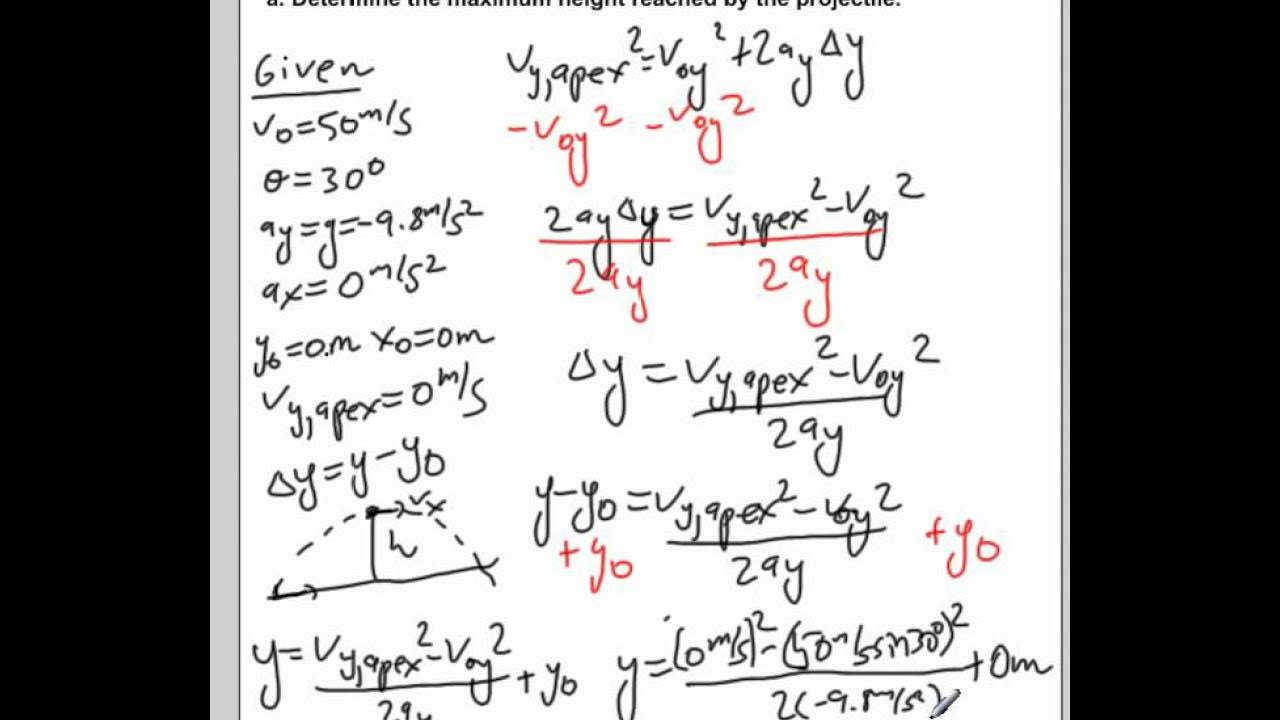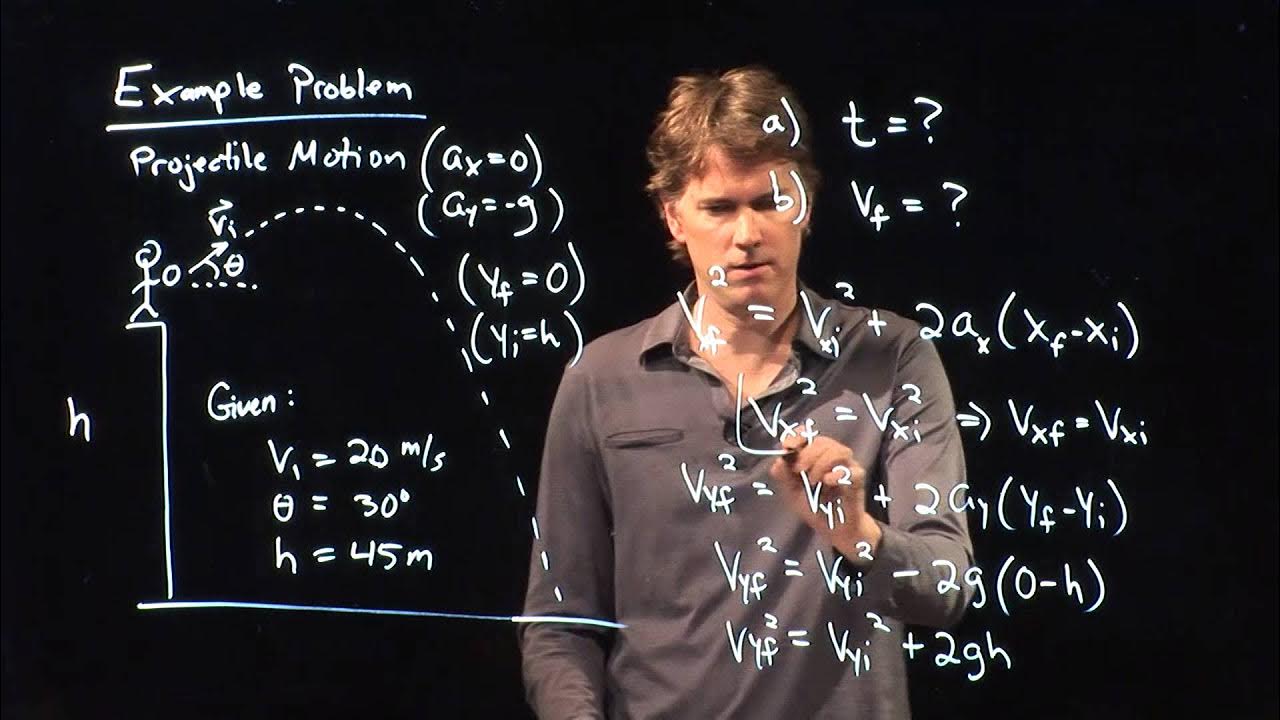Win the Prize Projectile Motion Problem
TLDRIn this educational video, the host tackles problem 3.19 from Young and Friedman's 'University Physics' textbook, which involves projectile motion. The scenario is a carnival game where a quarter must be tossed into a dish 2.1 meters away. The host calculates the shelf's height and the coin's vertical velocity before landing, given an initial velocity of 6.4 m/s at a 60-degree angle. The solution uses kinematic equations, ignoring air resistance, and finds the shelf's height to be 1.527 meters and the vertical velocity component to be -0.89 m/s, just before the coin lands. The video is designed to help viewers understand the physics of projectile motion and is suitable for students and learners.
Takeaways
- 🎯 The problem is from Young and Friedman's 'University Physics' textbook, specifically problem 3.19 titled 'Win the Prize'.
- 🔍 The scenario involves tossing a quarter into a dish at a carnival booth to win a prize, with the dish located 2.1 meters horizontally from the point of release.
- 🚀 The coin is tossed with an initial velocity of 6.4 m/s at a 60-degree angle above the horizontal, and air resistance is ignored.
- 📏 The task is to find the height of the shelf above the point where the quarter is released and the vertical component of the coin's velocity just before it lands.
- 📚 The problem provides a diagram, which helps visualize the situation and the given parameters.
- 📉 The horizontal component of the initial velocity (vix) is calculated using the cosine of the angle, resulting in 6.4 * cos(60).
- 📈 The time of flight is found by dividing the horizontal distance by the horizontal component of the initial velocity, yielding 2.1 / (6.4 * cos(60)) seconds.
- ⏱ The calculated time of flight is approximately 0.65625 seconds, which is used to find the vertical displacement.
- 📊 The vertical displacement (dy) is calculated using the kinematic equation dy = viy * t + 0.5 * a * t^2, where a is the acceleration due to gravity (-9.8 m/s^2).
- 📐 The height of the shelf (dy) is found to be approximately 1.527 meters above the point where the quarter is released.
- 🌟 For part B, the vertical component of the coin's velocity just before landing (vfy) is calculated using the equation vfy = viy + a * t, resulting in -0.89 m/s.
Q & A
What is the main objective of the problem presented in the video?
-The main objective of the problem is to determine the height of the shelf above the point where the quarter leaves the hand and to find the vertical component of the velocity of the quarter just before it lands in the dish.
What textbook does the problem come from?
-The problem comes from Young and Friedman's 'University Physics' textbook.
What is the initial velocity of the quarter when tossed?
-The initial velocity of the quarter when tossed is 6.4 meters per second.
At what angle is the quarter tossed with respect to the horizontal?
-The quarter is tossed at a 60-degree angle above the horizontal.
What is the horizontal distance from the point where the quarter is released to the dish?
-The horizontal distance from the point where the quarter is released to the dish is 2.1 meters.
What is the first step in solving the problem?
-The first step in solving the problem is to calculate the time of flight using the horizontal motion equations.
How is the time of flight calculated in the video?
-The time of flight is calculated by dividing the horizontal distance (2.1 meters) by the horizontal component of the initial velocity (6.4 m/s * cos(60 degrees)).
What is the formula used to find the vertical height (dy) of the shelf?
-The formula used to find the vertical height (dy) is dy = viy * t + 0.5 * a * t^2, where viy is the initial vertical velocity, a is the acceleration due to gravity, and t is the time of flight.
What is the calculated height of the shelf above the point where the quarter leaves the hand?
-The calculated height of the shelf is 1.527 meters above the point where the quarter leaves the hand.
What is the vertical component of the velocity of the quarter just before it lands in the dish?
-The vertical component of the velocity of the quarter just before it lands in the dish is -0.89 meters per second.
Why is the formula vfy = viy + a*t preferred over vfy^2 = viy^2 + 2*a*dy in this context?
-The formula vfy = viy + a*t is preferred because it does not involve squaring the velocities, which can lead to a loss of information regarding the direction of motion.
What does the speaker suggest doing if the viewer finds the video helpful?
-The speaker suggests liking, subscribing, and sharing the video with friends or classmates if the viewer finds it helpful.
Outlines
🎯 Projectile Motion Problem Introduction
This paragraph introduces a physics problem from Young and Friedman's 'University Physics' textbook, specifically problem 3.19 titled 'Win the Prize in a Carnival Booth.' The problem involves tossing a quarter into a small dish to win a prize. The dish is located 2.1 meters horizontally from the point where the quarter is released, and the quarter is tossed with an initial velocity of 6.4 m/s at a 60-degree angle above the horizontal. The goal is to determine the height of the shelf and the vertical component of the quarter's velocity just before it lands in the dish, assuming no air resistance. The paragraph outlines the given information and sets up the problem by discussing the initial velocity components and the horizontal distance to the dish.
📚 Solving for the Height of the Shelf
The speaker begins by calculating the time of flight for the quarter using the horizontal component of its initial velocity and the horizontal distance to the dish. They find the time to be approximately 0.65625 seconds. With the time determined, they proceed to use kinematic equations to find the vertical height (d_y) the quarter travels before landing in the dish. The vertical component of the initial velocity is calculated, and the kinematic equation d_y = vi_y * t + 0.5 * a * t^2 is applied, where a is the acceleration due to gravity (-9.8 m/s^2). The calculated height of the shelf is 1.527 meters above the point where the quarter is released.
🚀 Calculating the Vertical Velocity Component Before Landing
In this paragraph, the focus shifts to solving for the vertical component of the quarter's velocity (vf_y) just before it lands in the dish. The speaker uses the kinematic equation vf_y = vi_y + a * t, avoiding the squared version of the equation to preserve direction information. By plugging in the values for the initial vertical velocity component, acceleration due to gravity, and the time of flight, they calculate the final vertical velocity to be approximately -0.89 m/s, indicating a downward velocity as the quarter lands. The paragraph concludes with a note on the difficulty level of the problem, described as a two-dot problem, and a reminder to the viewers about the potential for different numbering in various editions of the textbook.
📢 Conclusion and Viewer Engagement
The final paragraph wraps up the problem-solving session by summarizing the solutions found for both parts of the problem: the height of the shelf (1.527 meters) and the vertical component of the quarter's velocity just before landing (-0.89 m/s). The speaker encourages viewers to ask questions or provide feedback via comments or email if they find the explanation helpful. They also remind viewers to like, subscribe, and share the video with friends or classmates, emphasizing the value of the content for educational purposes. The video concludes with a thank you and a goodbye, setting the stage for future sessions.
Mindmap
Keywords
💡Projectile Motion
💡Initial Velocity
💡Horizontal Distance
💡Angle of Projection
💡Time of Flight
💡Vertical Component
💡Acceleration Due to Gravity
💡Kinematic Equations
💡Carnival Booth
💡Problem Solving
💡Diagram
Highlights
Introduction to problem 3.19 from Young and Friedman's University Physics textbook.
Problem involves winning a prize at a carnival booth by tossing a quarter into a dish.
The dish is located 2.1 meters horizontally from the point where the quarter is released.
The coin is tossed with an initial velocity of 6.4 m/s at a 60-degree angle above the horizontal.
Air resistance is ignored in the problem.
Objective is to find the height of the shelf above the release point.
The problem is broken down into two parts: finding the height (Part A) and the vertical velocity component before landing (Part B).
Uses the given diagram to understand the problem setup.
Calculates the horizontal component of the initial velocity using cosine of 60 degrees.
Determines the time of flight by dividing the horizontal distance by the horizontal velocity.
Finds the time of flight to be 0.65625 seconds.
Uses kinematic equations to find the vertical height (d_y) of the shelf.
Calculates the vertical height to be 1.527 meters above the release point.
Problem difficulty is rated as two blue dots, indicating a moderate level of challenge.
For Part B, the vertical component of the velocity (vf_y) is calculated using the time found earlier.
The vertical velocity component just before landing is found to be -0.89 m/s.
Encourages viewers to ask questions, like, subscribe, and share the video if it was helpful.
Transcripts
Browse More Related Video
5.0 / 5 (0 votes)
Thanks for rating:





